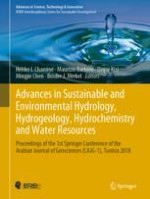This book comprises the selected papers from the 1st Springer Conference of the Arabian Journal of Geosciences (CAJG-1), Tunisia 2018. The volume is of interest to all researchers and practitioners in the fields of Hydrology, Hydrogeology, Hydrochemistry, Water Resources and Hydrologic Engineering.
Water is a dynamic, finite, and vulnerable but resilient natural resource to be protected in an environmentally sustainable manner. Water systems in different frameworks requires a comprehensive understanding of climatology, geology, hydrogeology, hydrochemistry, hydrodynamics, and surface hydrology. In addition, it is highlighted the role of the variability and climate change in water systems. Furthermore, water has a vital significance to the entire socio-economic sector.
This volume offers an overview of the state-of-the-art related to water science and technology in model regions in Europe, Africa, Middle East, Asia and America, but mainly focuses on the Mediterranean environment and surrounding regions. It gives new insights on characterisation, evaluation, quality, management, protection, modelling on environmental hydrology, groundwater, hydrochemistry, sustainable water resources studies and hydrologic engineering approaches by international researchers.
Main topics include:
1. Hydrology, Climatology and Water-Related Ecosystems
2. Hydrochemistry and Isotopic Hydrology
3. Groundwater Assessment and Management: mapping, exploration, abstraction and modelling
4. Water Resources Sustainability and Climate Change
5. Hydrologic Engineering and Urban Groundwater
